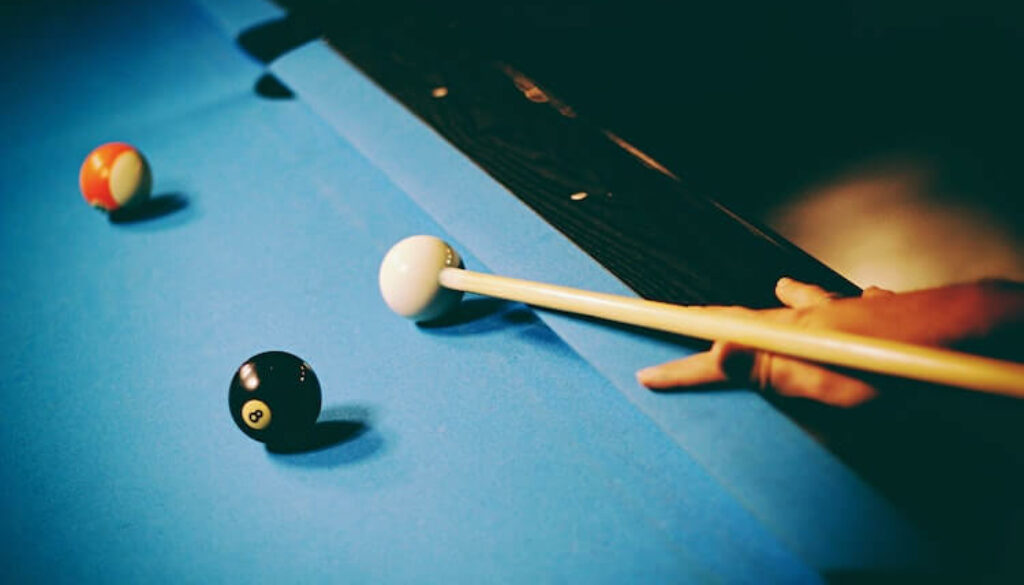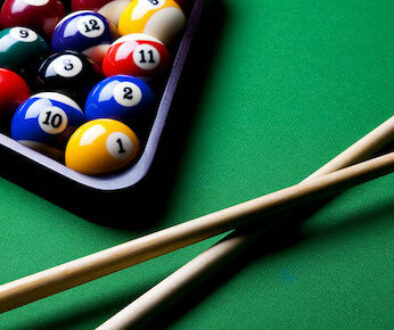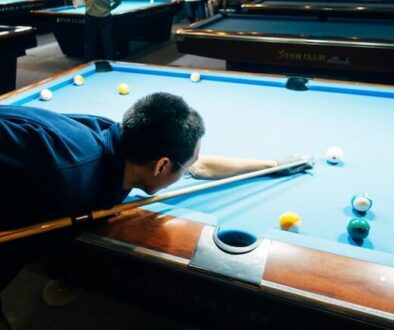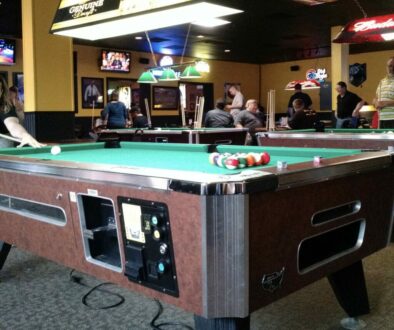The Pool Cue – A Complete Guide
Thanks to pool cues, we are able to play the game we love. There are many types of cues that players can use to their advantage and they can be as simple as a common bar cue, or they can be super intricate and quite expensive.
In this article, we’ll help equip you with all the basic knowledge you’ll need about pool cues. Knowledge that might help make a future purchase decision, or simply help educate a new pool player.
What is a Pool Cue?
A pool cue, also known as a cue stick, is a tool that is used to play billiards games such as pool and snooker. It’s used to aim and hit a cue ball into object balls.
These are usually tapered sticks that are 56 to 58 inches long on average (1.5m) and weigh about 16 to 20 ounces.
Types of Pool Cues
There are three common types of pool cues:
- One-piece/house cues
- Two-piece/players cues
- Jump/break cues
There is no best type of pool cue. It really depends on the player and their preferences. Before investing in a cue, it’s important to do your research to understand what type of cue will fit you best.
One-Piece/House Cue
As the name suggests, a one-piece pool cue, or a house cue, is a cue that is made up of one piece of wood. The house cue is the most common type of cue, commonly found at pubs and bars or at your friend’s house for use as a guest’s pool cue.
One-piece cues are perfect for people who are looking to play a few quick games and be on their way. However, one-piece pool cues aren’t the easiest to carry and are often used by inexperienced players, so they have a tendency to get a little beat up.
On the other hand, a lot of people are fond of the simplistic, uniform design of the house cue and prefer it over others.
Two-Piece/Players Cue
A two-piece cue is a cue that has a joint right in the middle. This simply means that the cue can be quickly disassembled and can be transported easily.
A two-piece cue is popular among professional players and pool enthusiasts. These types of cues are not only easier to carry around, but also take up much less space when stored away.
Two-piece cues are more expensive, but that’s because they offer more performance and technology for the advanced player.
Jump/Break Cues
A jump cue, or break cue, is a pool cue that players hit breaks and/or jump shots with. These are often used while playing 8-ball, 9-ball or 10-ball pool.
When players hit jump shots, they are forcefully hitting the cue ball against the table to bounce (or jump) the ball off the table and over other object balls.
This type of cue can either be a jump & break cue combination, or just a break cue. Break cues typically come as 2-piece cues, and jump/break combo cues can be up to 3 pieces.
What are Pool Cues Made Of?
Most pool cues are made of wood, but there are a few other materials pool cues can be made of. Each different material will provide a unique feel while playing.
Keep in mind, pool cue material is often just a personal preference, but there are certainly pros and cons of each when you compare them.
Fiberglass Pool Cues
Fiberglass is one material that pool cues can be made with. A cheaper option than wood or carbon fiber, fiberglass pool cues are great for beginners on a tight budget, and provide a firm hit on the cue ball.
Pros:
- Fiberglass pool cues are lightweight and require minimum maintenance
- Fiberglass pool cues are easy on the wallet as they are super affordable
- Less affected by the atmosphere so they do not degrade
- Graphite is resistant to warping and sometimes looks better visually
Cons:
- A fiberglass pool cue might not be the best option for someone with sweaty hands as it can get sticky and affect performance
- If you are an experienced pool player, you may not like the feel of a fiberglass pool cue as it may feel inauthentic
- If any significant damage is done to a graphite pool cue, it usually cannot be repaired
- The ball contact made from a fiberglass pool cue may not feel as solid as contact made with a wood pool cue
Wood Pool Cues
The traditional and most authentic type of pool cue is made from wood – more specifically, maple wood, as it provides the most solid contact and softest feel.
There are wood pool cues available at many different prices depending on the brand, the technology, and the time it takes to make the cue.
Pros:
- Wood cues are easier to repair if damaged
- Wood cues are super durable and will last for years if maintained properly
- A wood shaft can stay smooth for longer
- Great for beginners as well as professionals
Cons:
- Wood is often more expensive
- Prone to warping if not maintained properly
- Require more cleaning
- Can scratch and ding
The Parts of a Pool Cue
A new pool player should be aware of all the parts that make up the pool cue they will be using. Knowing your pool cue is integral to having success on the table. The more someone understands how their cue functions, the better they will be.
A pool cue is made up of seven parts, namely: The tip, ferrule, shaft, forearm, wrap, butt, and butt cap.
1. Tip
The tip is the uppermost part of a pool cue and is also the part that makes first contact with the cue ball. It is typically made of leather and ranges from 11mm to 14mm in size.
A pool cue’s tip hardness can be adjusted. If a player wants their hit to be stronger, they should choose a harder tip; on the other hand, if a player wants more control over their hit, they should use a softer tip.
A cue’s tip is attached to the stick’s ferrule by using a strong-hold glue.
2. Ferrule
A ferrule may seem insignificant at first and may not be that important to pool players who are just starting, but it does serve an important role.
The ferrule keeps the shaft from falling apart and also absorbs the vibrations made from hitting a billiard ball. Ferrules are usually white and made of phenolic or ivory but some ferrules are also made from wood.
3. Shaft
The shaft is the top half of a cue stick which is most often made of maple wood. But, carbon fiber shafts are becoming increasingly popular.
A pool cue shaft is very smooth to allow the shaft to glide through the fingers seamlessly and create less friction while shooting. It helps the player stay consistent.
4. Forearm
The forearm is the longest part of the bottom half of a pool cue and it’s also where you’ll find most of the inlays (designs that are set into the wood) and overlays (decals that are designs set on top of the wood).
It typically has a glossy coating which helps protect it from the wear and tear that it goes through during normal play.
5. Wrap
The wrap is located just below the forearm of a pool cue and helps a player maintain a steady grip on the cue.
Some cues have wraps, and some don’t – it really depends on the player’s preference. Cue wraps also absorb excess moisture on hands to help players grip the pool cue better. It is usually recommended to use a wrap because of the added leverage and control it provides.
6. Butt
A butt is another part of the pool cue where you’ll find more design work, either identical or in continuation of the forearm artwork.
The butt helps adjust the weight of the pool cue which makes it one of the most important parts of the cue stick. It is usually hollow on the inside and comes with a weight bolt to adjust how heavy or light the stick needs to be to play optimally.
7. Butt Cap
Located at the bottom of the cue stick, a butt cap also contributes to the weight adjustment system. It reinforces the pool cue and protects the bottom part of the cue from damage since the bottom of the cue is making lots of contact with the ground.
How to Maintain Your Pool Cue
Pool players needs to take good care of their equipment in order to maintain a consistent performance. If you don’t take care of the equipment you use while playing pool, your performance will suffer as the cue stick takes on wear and tear after every game.
To take the best care of your pool cue, there are certain items you must have at your disposal to clean and store your pool cues properly so they don’t break or take on any damage from their surroundings.
Some of these must-have items include a case for your pool cue, chalk, tip scuffer or shaper, and shaft cleaner. Each of these items serves a different purpose to take the best care of your pool cue.
Storing Your Pool Cue
Pool cue storage is very important. How your cue stick performs or how fast it degrades heavily depends on how you store it.
If inside, a cue stick needs to be in a temperature-controlled and humidity-controlled environment away from extreme temperature. Preferably in a cue case.
Extreme temperatures cause damage to the pool cue in the form of warping and degradation. It is best to set your cue straight (up and down) indoors and keep it in a case outdoors to keep it safe from the temperature fluctuations or any other damage that can be caused outside.
Using a cue case is pretty simple – you need to store the cue vertically inside the case with enough space for air to pass through to let the pool cue breathe.
Chalking
It’s always important to make sure your cue stick is chalked properly to keep it good as new and to take better shots. To chalk the tip of the pool cue, you first need to make sure that the chalk is either new or that the surface of the chalk is not too flat.
Rub the chalk on the tip of the pool cue making sure to cover the entire surface. This prevents the ferrule from getting stained. Make sure to never grind or push on the tip of the cue stick as it may leave a stain. Light pressure is all you need.
Scuffing/Shaping
The tip of your cue stick is arguably the most important part. The cue tip makes contact with the ball and pushes it in the right direction. As a result, the tip of your pool cue can flatten over time.
After playing with your pool cue and chalking it time and again, the surface tends to lose its sharpness and that is why scuffing (or shaping) the pool cue’s tip is necessary.
There are plenty of tools available on the market to do this. Some tip maintenance kits have a built-in scuffer or shaper that a player can use every few games. Simply run the scuffer over the tip or take a tip-prick and poke it gently.
Cue Shaft Cleaning
The shaft of the pool cue can get super messy and grimy after a while, however, you don’t need many skills to clean a cue shaft.
One thing to remember – do not use alcohol when cleaning your wood pool cue shaft. Alcohol will dry out the natural moisture in the wood and slowly eat away at the material.
The first step is to take an microfiber cloth or a slightly damp paper towel and wrap it around your cue while sliding it up and down.
Once you have gotten rid of all the grime, you can find products to sand and burnish the pool cue lightly. This helps with getting rid of any residual dirt on the pool cue.
The last step is to apply cue wax. This gives your cue stick a smooth and shiny finish and also adds a protective layer over your cue.
For a more detailed look into how to clean your pool cue, check out our recent article on cue maintenance.
Most Popular Pool Cue Brands
Listed below are some of the most well-known brands that sell pool cues. Below, we will be analyzing the type of pool cues they sell, the price range, and the quality.
- McDermott: McDermott is one of the most prestigious brands in the pool industry and they are known for their high-quality products and the countless customizations they offer. The brand sells pool cues ranging from $300-$2000+.
- Cuetec: Cuetec is another well-known brand that sells cue sticks and additional accessories. They are based in the U.S. and have been in business since 1989. They are known to produce extremely high-quality fiberglass cues and sell affordable cues starting at the price of $159.
- Predator: Predator has been around since 1994 and prides itself in making pool cues that are scientifically proven to be better and specifically engineered to give the players a better experience. They operate out of Jacksonville, Florida, and their price ranges from $200-$2500 with many customization options available.
- Lucasi: Lucasi has been around for 20 years and makes custom and hybrid pool cues. They make uni-lock and exotic wood cues that help them stand out from the competition. Everything they sell comes with a 60-day satisfaction guarantee and their pool cues start from $300 and go up to $700.
- Meucci: Meucci Cues are a brand that makes high-quality pool cues that are used by everyone from beginners to professional players. Although not the most popular brand, Meucci makes some of the best pool cues that are ranged over $425-$2845. Their pool cues are different, unique, and stand out from many others.
- Viking: Viking Cues are exclusively made in the U.S. and have an impeccable 50-year history of selling high-quality products to their customers. All Viking cues come with a lifetime guarantee and one can find these cues ranging anywhere from $50 to $2000.
- Jacoby: Jacoby started in a basement where the owner of the brand and his son repaired pool cues and eventually made their first one. They started their first shop in 1992 and the company has been growing since then. They have a huge selection of cues available on their website and are a great solution for all kinds of pool players! Their cues are a bit more expensive than most others with prices going up to $21,000.
- Mezz: Mezz pool cues have been around for 50 years. Mezz cues are manufacturing the highest quality cue sticks straight from Japan. They are also known for their accessories and have unique technology that makes their pool cues stand out. Mezz pool cues usually range between $500-$900.
- Pechauer: Pechauer is known for making some of the best custom pool cues – ensuring a great fit for their customers. They make their cues in Green Bay, Wisconsin using a sawmill and are dried in a specialized kiln that preserves the whiteness of the wood. They have different selections of pool cues available in the price range of $330-$6000.
Wrap Up
Like any other game, pool takes time to master. However, having the right pool cue at your side takes a lot of the load off the player.
It’s important to know that something that works for one person may not work for you. The good news is that there are countless options available, so, chances are you will easily find something that works for you with a little effort.
As always, Happy Shooting!




